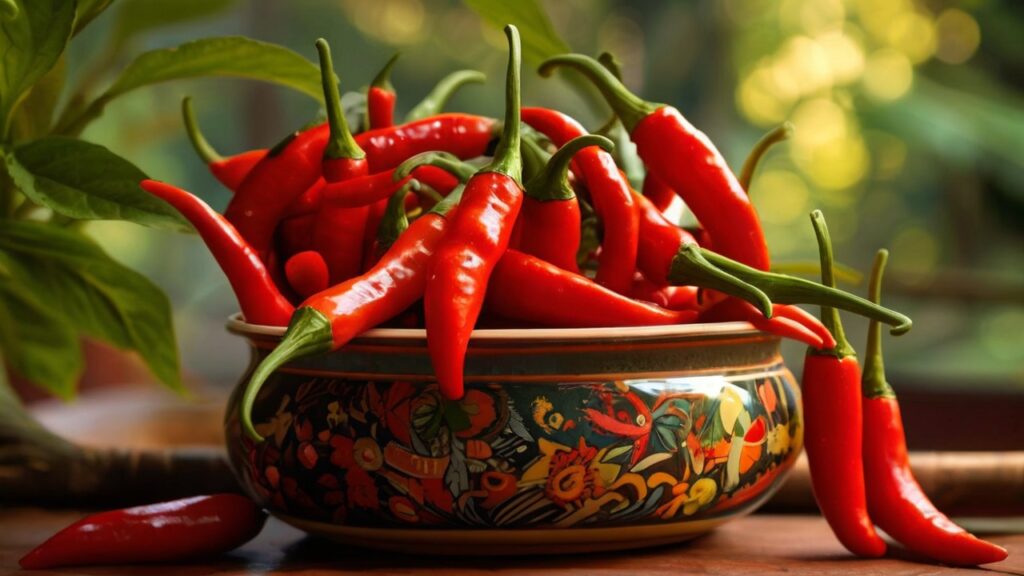Introduction :
Red chillies are known for their sharp and hot taste. When unripe its green fruits are used to prepare pickles and dishes and the ripe red fruits are used in dried form to prepare spices. It has 3-5 varieties that are very well known and do not need any further introduction.
Chemical Composition :
It contains a bitter chemical called capasaicin, which is responsible for its bitterness, sharp and hot nature. It contains proteins, fats, carbohydrates, small amounts of mineral nutrients like, iron, phosphorus, calcium. It also contains vitamin-C and carotene. In addition, vitamin E, aluminum, barium, copper, lithium, manganese, silicon, titanium are also found in small amounts. From dried fruits thick red stable oil is extracted and by distilation a volatile oil is extracted.
Properties :
It suppresses kapba, sats, promotes bile and is lekban (scraping). It purifies blood, cures gastric problems and sleeplessness. It stimulates the heart and clenses the urinary system. It is anti-pyretic, and especially effective in controlling dangerous fever. Due to its hot, sharp, and bitter nature, it induces saliva secretion helps digestion. In large amounts it leads to burning sensation.
Medicinal used :
Voice disorder: Prepare tablets of red chilli powder with powdered sugar and almonds. These tablets can be given to singers and regular speakers. It helps cure their voice problems.
Abdominal pain:
- Prepare tablet of 1 gm red chilli powder with 100 gm jaggery. Give this to the patient. It cures stomach pain.
- Give ½ gm red chilli powder with 2 gm dry ginger powder to the patient. It cures indigestion, stomach pain and swelling of the stomach caused by indigestion or accumulation of wind.
Anorexia: In case of disinterest toward food due to impact of pitta, or poor appetite, give as per requirement 5-20 drops of its oil filled in sugar. It improves the appetite.
Cholera:
- Separate the seeds and grind the outer skin into fine powder. Sieve it through fine cloth and mix camphor and asfoetida in it. In case camphor and asfoetida is not available, take only the chilli part. Mix them in honey and prepare tablets of 250 mg each. Give these tablets to be swallowed. It revives sinking pulse and normalizes it.
- Give tablet of poppy seeds and asfoetida and then give the decoction of red chillies.
- In cholera after every vomit and stool, give ½ teaspoonful red chilli oil to the patient. Within 2-3 times, it gives relief to the patient.
- Grind the chillies into fine powder and prepare berry shaped tablets. Give 1-1 tablet with 7 cloves at an interval of 1 hour, to the cholera patient. It gives relief in all phases of cholera
Growth Requirements:
- Climate: Warm, frost-free conditions are ideal. They thrive in temperatures between 70–85°F (20–30°C) and are sensitive to frost.
- Soil: Well-drained, fertile soil with a pH between 6.0 and 7.0 is best. Chili plants prefer loamy or sandy soil enriched with organic matter.
- Sunlight: Full sunlight for at least 6-8 hours a day is essential for optimal growth.
- Watering: Regular watering is needed, but overwatering should be avoided to prevent root rot. The soil should be kept consistently moist but not soggy.
- Fertilization: Chili plants benefit from balanced fertilizers during growth and high-potassium fertilizers during fruiting.
Propagation:
- Seeds: Most chili plants are grown from seeds. The seeds are usually started indoors 8-12 weeks before the last frost date. Germination occurs best at temperatures around 75–85°F (24–29°C).
- Transplanting: Once the seedlings are 2–3 inches tall and all risk of frost has passed, they can be transplanted outdoors.
Common Pests and Diseases:
- Pests: Aphids, spider mites, and whiteflies are common pests. Neem oil and insecticidal soaps can help control infestations.
- Diseases: Chili plants can suffer from fungal diseases like powdery mildew and root rot, as well as bacterial and viral infections. Proper spacing, good air circulation, and avoiding waterlogged soil can help prevent these issues.

Harvesting:
- Time to Harvest: Chili peppers are usually ready for harvest 60–150 days after transplanting, depending on the variety.
- Ripeness: The color of ripe chili peppers varies by type, ranging from green to red, yellow, orange, or purple. The fruits can be picked when they reach the desired color or maturity level.
Uses:
- Culinary: Chili peppers are used fresh, dried, or ground into powder. They are popular in various cuisines around the world, adding heat and flavor to sauces, stews, curries, and marinades.
- Medicinal: Capsaicin, the compound responsible for the heat, has medicinal properties, including pain relief and anti-inflammatory effects. Chili peppers are also rich in vitamins A, C, and E.
- Cultural Significance: Chili peppers are integral to the cuisines of many cultures, particularly in Latin America, Asia, and Africa. They are also part of traditional medicine in some cultures.
